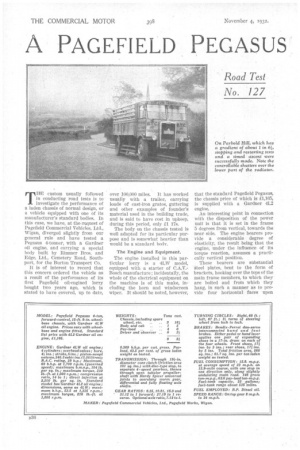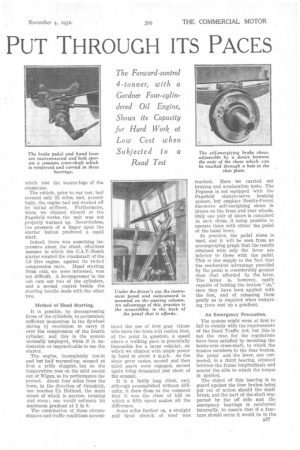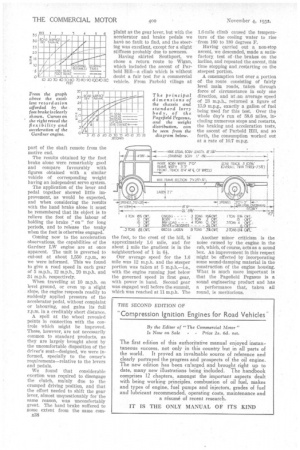PEGASUS PUT THROUGH ITS PACES
Page 54

Page 55

Page 56

If you've noticed an error in this article please click here to report it so we can fix it.
Road Test
No. 127
TFTC custom usually followed in conducting road tests is to investigate the performance of a laden chassis of normal design, or a vehicle equipped with one of its manufacturer's standard bodies. In this case, we have, at theq.nquest of Pagefield Commercial Vehicles, Ltd., Wigan, diverged slightly from our general rule and have tested a Pegasus 4-tonner, with a Gardner oil engine, and carrying a special hotly built by Rimmer Bros. and Edge, Ltd., Cemetery Road. Southport, for the Burton Transport Co.
It is of interest to record that this concern ordered the vehicle as a result of the performance of its first Pagefield oil-engined lorry bought two years ago, which is stated to have covered, up to date, over 100,000 miles. It has worked usually with a trailer, carrying loads of cast-iron grates, guttering and other examples of founder's material used in the building trade, and is said to have cost in upkeep, during this period, only fi 17s.
The hotly on the chassis tested is well adapted for its particular purpose and is somewhat heavier than would be a standard 144-)dv_
The Engine and Equipment.
The engine installed in this particular lorry is a 41,\V model, equipped with a starter of C.A.V.Bosch manufacture ; incidentally, the whole of the electrical equipment on the machine is of this make, including. the horn and windscreen wiper. It should be noted, however, that the standard Pagefield Pegasus, the .chassis price of which is £1,165, is supplied with a Gardner 4L2 engine.
An interesting point in connection with the disposition of the power unit is that it is set in the frame 5 degrees from vertical, towards the near side. The engine hearers provide a considerable degree of elasticity, the result being that the engine, under the influence of its torque reaction, assumes a practically vertical position.
These bearers are substantial §teel plates, bent to the form of brackets, hooking over the tops of the main frame members, to which they are bolted and from which they hang, in such a manner as to provide four horizontal faces upon which rest the bearer-lugs of thsi crankcase.
The vehicle, prior to our test, had covered only 85 miles, and, accordingly, the engine had not worked off its initial stiffness. Furthermore, when we climbed aboard at the Pagefleld works, the unit was not properly warmed up. Nevertheless, the pressure of a finger upon the starter button produced a rapid start.
Indeed, there was something impressive about the silent, effortless manner in which the C.A.V.-Bosch starter rotated the crankshaft of the 5.6 litre engine, against its 14-to-1. compression ratio. Hand starting from cold, we were informed, was not difficult. A decompressor in the cab cuts out two of the cylinders, and a second control beside the starting handle deals with the other two.
Method of Hand Starting.
It is possible, by decompressing three of the cylinders, to accumulate sufficient momentum in the flywheel during 11 revolution to carry it over the compression of the fourth cylinder, and this is the system normally 'employed,, when it is undesirable or impracticable to use the starter.
The engine, incompletely run-in and but half warmed-up, seemed at first a trifle sluggish, but as the temperature rose on the mild ascent out of Wigan, so its performance improved. About four miles from the town, in the direction of Ormskirk, one reaches Up Holland, the main street of which is narrow, twisting and steep ; one would estimate its maximum gradient at 1 in 8. The combination of these circumstances and traffic conditions necessi tated the use of first gear (those who know the town will realize that, at the point in question, a speed above a walking pace is practically impossible for a large vehicle), on which we climbed with ample power in hand at about 4 m.p.h. As the slope grew easier, second and then third gears were engaged, second again being demanded just short of the summit.
It is a fairly long climb, and, although accomplished without difficulty, it drew from us the comment that it was the class of hill on which a fifth speed makes all the difference.
Some miles farther on, a straight and level stretch of road was reached. Here we carried out braking and acceleration tests. The Pegasus is not equipped With the Pagefield eleetric-servo braking system, but employs Bendix-Perrot duo-servo self-energizing shoes in drums on the front and rear wheels. Only one pair of shoes is contained in each drum, it being possible to operate them with either the pedal or the hand lever.
In practice, the pedal alone is used, and it will be seen from an accompanying graph that the results obtained with only the lever are inferior to those with the pedal. This is due simply to the fact that the mechanical advantage provided by the pedal is considerably greater than that afforded by the lever. The latter is, however, easily capable of bolding the brakes "on," once they have been applied with the foot, and of releasing them gently as is required when restarting from rest up a gradient.
An Emergency Precaution.
The system might seem at first to fail to comply with the requirements of the Road Traffic Act, but this is not the case, for the regulations have been satisfied by mounting the brake-arm cross-shaft, to which the tension members to the four brakes, the pedal and the lever, are connected, in a third bearing, situated between the frame longitudinals and nearer the side to which the torque is applied.
The object of this bearing is to guard against the four brakes being put out of action should the shaft break, and the part of the shaft supported by the off side and the emergency bearings is reinforced internally, to ensure that if a fracture should occur it would be in the part of the shaft remote from the motive end.
The results obtained by the foot brake alone were remarkably good and compare favourably with figures obtained with a similar vehicle of corresponding weight having an independent servo system.
The application of the lever and pedal together showed little improvement, as would be expected, and when considering the results with the hand brake alone it must be remembered that its object is to relieve the foot of the labour of holding the brake " on " for long periods, and to release the Drake when the foot is otherwise engaged.
Coming now to the acceleration observations, the capabilities of the Gardner LW engine are at once apparent. The unit is governed to cut-out at about 1,550 r.p.m., so we were informed. This we found to give a road speed in each gear of 5 m.p.h., 12 m.p.h., 20 m.p.h. and 34 m.p.h. respectively.
When travelling at 10 m.p.h. on level ground, or even up a slight slope, the engine responds readily to suddenly applied pressure of the accelerator pedal, without complaint or labouring, and gains its full r.p.m. in a creditably short distance.
A spell at the wheel revealed points in connection with the controls which might be improved. These, however, are not necessarily common to standard products, as they are largely brought about by the uncomfortable disposition of the driver's seat—designed, we were informed, specially to the owner's requirements—relative to the levers and pedals.
We found that considerable exertion was required to disengage the clutch, mainly due to the cramped driving position, and that the effort needed to shift the gear lever, almost unquestionably for the same reason, was uncomfortably great. The hand brake suffered to some extent from the same com n38 plaint as the gear lever, but with the accelerator and brake pedals we have no fault to find, and the steering was excellent, except for a slight stiffness probably due to newness.
Having skirted Southport, we chose a return route to Wigan, which included the ascent of Parbold Hill—a climb which is without doubt a fair test for a commercial vehicle. From Parbold village at the foot, to the crest of the hill, is approximately 1.6 mile, and for about mile the gradient is in the neighbourhood of 1 in 6-i.
Our average speed for the 1.6 mile was 12 m.p.h. and the steeper portion was taken at 5 m.p.h.—i.e., with the engine running just below the governed speed in first gear, with power in hand. Second gear was engaged well before the summit, which was reached at 11 m.p.h. The 1.6-mile climb caused the temperature of the cooling water to rise from 160 to 180 degrees F.
Having carried out a non-stop ascent, we descended, made a satisfactory. test of the brakes on the incline, and repeated the ascent, this time stopping and restarting on the steepest portion.
A consumption test over a portion of the route consisting of fairly level main roads, taken through force of circumstance in only one direction, and at an average speed of 23 m.p.h., returned a figure of 15.9 m.p.g., exactly a gallon of fuel being used for this test. Over the whole day's run of 58.6 miles, including numerous stops and restarts, the braking and acceleration tests, the ascent of Parbold Hill, and so forth, the consumption worked out at a rate of 10.7 m.p.g.
Another minor criticism is the noise caused by the engine in the cab, which, of course, acts as a sound box. An improvement in this respect might be effected by incorporating some sound-damping material in the construction of the engine housing. What is much more important is that the Pagefield Pegasus is a sound engiaeering product and has a performance that, taken all round, is meritorious.




































































































